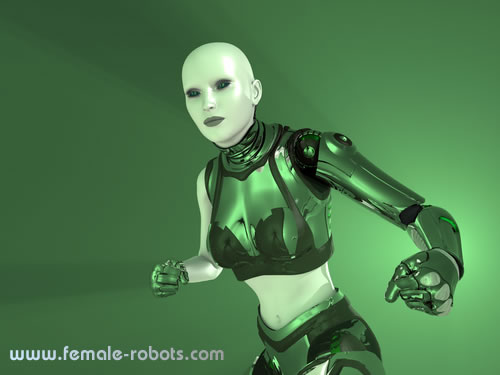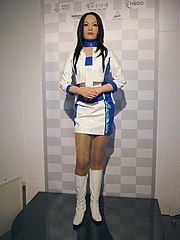Posts Tagged ‘cyborg’
 Ghost in the Shell New Movie
Ghost in the Shell New Movie
Coming soon the long awaited Japanese Manga adaptation “Ghost in the Shell” new movie with Scarlett Johansson, a humanoid female police officer against a computer hacker – release due March 2017. The original anime movie from 1995 is worth watching.
Official Trailer
Ghost in the Shell
Anime
In depth
https://en.wikipedia.org/wiki/Ghost_in_the_Shell
Ghost in the Shell Cast
http://www.imdb.com/title/tt1219827/
A Hong-Kong man designed a real robot called Mark 1 modelled after a mysterious hollywood star – your guess!
 Ghost in the Shell in 3D
Ghost in the Shell in 3D
Ghost in the shell started as a manga novel (created by Masamune Shirow in 1989), its huge success lead to the production of animated films, anime series, video games and novels, and is said to have inspired the Matrix. It focuses on the activities of the counter terrorist organization Public Security Section 9 in a futuristic Japan (year 2034) specialized in fighting technology related crime. the heroin is a female cyborg named Motoko Kusanagi, she has superhuman / bionic powers thanks to her mechanical body; only her brain and a segment of her spinal cord remain organic, the rest of her body is synthetic. This character has been a great source of inspiration for digital artists working on the female robot theme. Motoko is also following a quest for existential meaning. Dreamworks has secured the rights to adapt Ghost in the Shell, set to be produced by Stephen Spielberg and released in 2011 as a live-action movie in 3D – More info about Ghost in the Shell on Wiki Ghost in the Shell >> and about the cyborg character Motoko Kusanagi >>
Ghost in the shell trailer –
available in HD 1080
Ghost in the Shell Official Website >>
Ghost in the Shell Toy Figurines pictures & blogpost by toybot >>
and the weird stuff:
Ghost in the Shell body painting costume >>
 Cyborg Woman fighting back
Cyborg Woman fighting back
Watch out! – Artwork by Dark Geometry Studios

 Welcome to the Ultimate Female Robots Inc
Welcome to the Ultimate Female Robots Inc
Welcome to www.female-robots.com. the great resource for sexy fembots, let’s start blogging, shall we?
First of all some definitions compiled from wiki:
A gynoid (from Greek γυνη, gynē – woman) is a humanoid robot designed to look like a human female, as compared to an android modeled after a male. The term is not common, however, with android being used to refer to both “genders” of robot. The word fembot (female robot) has also been used.
Gynoids have also been used as a metaphor in feminist discourse, as part of cyborg feminism, representing female physical strength and freedom from the expectation to reproduce. “Fembot” is sometimes used as an insult towards feminist women.
An Actroid is a humanoid robot with strong visual human-likeness developed by Osaka University and manufactured by Kokoro Company Ltd. (the animatronics division of Sanrio). It was first unveiled at the 2003 International Robot Exposition in Tokyo, Japan. Several different versions of the product have been produced since then. In most cases, the robot’s appearance has been modeled after an average young woman of Japanese descent.
The Actroid woman is a pioneer example of a real machine similar to imagined machines called by the science fiction terms android or gynoid, so far used only for fictional robots. It can mimic such lifelike functions as blinking, speaking, and breathing. The “Repliee” models are interactive robots with the ability to recognise and process speech and respond in kind.
A cyborg is a cybernetic organism (i.e., an organism that has both artificial and natural systems). The term was coined in 1960 when Manfred Clynes and Nathan Kline used it in an article about the advantages of self-regulating human-machine systems in outer space. D. S. Halacy’s Cyborg: Evolution of the Superman in 1965 featured an introduction by, who wrote of a “new frontier” that was “not merely space, but more profoundly the relationship between ‘inner space’ to ‘outer space’ -a bridge…between mind and matter.” The cyborg is often seen today merely as an organism that has enhanced abilities due to technology, but this perhaps oversimplifies the category of feedback.
Fictional cyborgs are portrayed as a synthesis of organic and synthetic parts, and frequently pose the question of difference between human and machine as one concerned with morality, free will, and empathy. Fictional cyborgs may be represented as visibly mechanical (e.g. the Cybermen in the Doctor Who franchise or Amber from the game Project Eden); or as almost indistinguishable from humans (e.g. the “Human” Cylons from the re-imagining of Battlestar Galactica). The 1970s television series the Six Million Dollar Man featured one of the most famous fictional cyborgs. Cyborgs in fiction often play up a human contempt for over-dependence on technology, particularly when used for war, and when used in ways that seem to threaten free will. Cyborgs are also often portrayed with physical or mental abilities far exceeding a human counterpart (military forms may have inbuilt weapons, among other things).
Real (as opposed to fictional) cyborgs are more frequently people who use cybernetic technology to repair or overcome the physical and mental constraints of their bodies. While cyborgs are commonly thought of as mammals, they can be any kind of organism.
An android is a robot or synthetic organism designed to look and act like a human. The word derives from ανδρός, the genitive of the Greek ανήρ anēr, meaning “man”, and the suffix -eides, used to mean “of the species; alike” (from eidos, “species”). Though the word derives from a gender-specific root, its usage in English is usually gender neutral. The term was first mentioned by St. Albertus Magnus in 1270 and was popularized by the French writer Villiers in his 1886 novel L’Ève future, although the term “android” appears in US patents as early as 1863 in reference to miniature humanlike toy automations.
Thus far, androids have largely remained within the domain of science fiction, frequently seen in film and television. However, some humanoid robots now exist.
The term “droid” – invented by George Lucas in Star Wars (1977) but now used widely within science fiction – although originally an abbreviation of “android”, has been used (by Lucas and others) to mean any robot, including distinctly non-humaniform machines like R2-D2.
A humanoid robot is a robot with its overall appearance based on that of the human body, allowing interaction with made-for-human tools or environments. In general humanoid robots have a torso with a head, two arms and two legs, although some forms of humanoid robots may model only part of the body, for example, from the waist up. Some humanoid robots may also have a ‘face’, with ‘eyes’ and ‘mouth’. Androids are humanoid robots built to aesthetically resemble a human.


